In the last few years, I have reviewed more lenses than you could possibly imagine.
My photography students are always asking which lens is right for them, so I spend a significant amount of time looking for lenses that offer superior quality at lower price points.
These are the best inexpensive Canon lenses I could find.
There are many others that I'm sure people will mention in the comments, but only 6 could make the cut for this list.
These lenses are the ones that I recommend very often on the Improve Photography Lens Finder.
I spent thousands of dollars and over a year developing the lens finder.
It basically asks you 5 questions about what lens you want, and then recommends the perfect lens for your situation.
I must mention from the outset that I use “the triad” of lenses (explained later), so I'm comparing the lenses in this list against the highest quality lenses in the Canon system at any price.
In all instances I have found these lenses to perform extremely well with Canon L lenses, but for WAY less money.
This is the good stuff–even when compared to the highest quality lenses money can buy.
Also, I must issue a disclaimer that the word “inexpensive” means different things to different people.
I am using the word “inexpensive” to compare these lenses to the top performing Canon L lenses that are generally priced around $2,000.
Tamron 28-75mm f/2.8 Lens
About a year ago, I had the opportunity to spend some time with a rep from Tamron and spend the day shooting just about all of the lenses in the Tamron lineup.
To be honest, I was not thrilled with most of them.
Most were “acceptable” and one lens was jokingly awful.
I finally couldn't take it anymore and I asked the rep to show me just the one best lens in the Tamron lineup.
He reached for the Tamron 28-75mm f/2.8. Skeptically, I played with it and shot with it for a while.
I was blown away at the quality from this lens.
I found this lens to be extremely close to the sharpness of the $2,400 Canon 24-70mm, and it adds one really impressive feature that the Canon doesn't–it's also a nice macro lens.
For me as a professional photographer, I would definitely take a long hard look at the Tamron 28-75mm before shelling out MORE THAN FOUR TIMES the cost to buy the Canon 24-70.
You can check the current price of this lens on Amazon.
You can also check KEH Camera to see if you can save some money on a REALLY high quality used one.
KEH Camera also has REALLY good financing option!
Canon 70-200mm f/4
Before you get lost in your excitement over the price of this Canon lens, notice that the f/stop only goes down to f/4 instead of the much-desired f/2.8 version of this lens (which costs about $2,500 dollars!).
To have an f/4 maximum aperture is not entirely negative; in fact, it gives you a lighter lens than the f/2.8 version with nearly equal optical quality.
The fast aperture will give you great results all the way through the lens to the edge of the photo.
In fact, many professional photographers who have used the 70-200mm f/2.8 for years are now switching over to this f/4 version to save some money and to lighten their load.
If you haven't used professional lenses before, you may not appreciate just how heavy they are, so saving weight by choosing this f/4 lens is a significant benefit over the $2,500 f/2.8 version of this lens.
This is probably the most popular lens for photographers buying their first professional-grade “L” lens (Canon's marker for their professional quality lenses).
There are two 70-200mm f/4 lenses available for the Canon system. Both are “L” glass, but one has image stabilization and one doesn't.
The image stabilized version is significantly more expensive, but the optical quality is similar between the two versions.
Click here to check the price of the less expensive non-IS version on Amazon, or else you can click here for the much more expensive version with IS on Amazon
You can also check KEH Camera to see if you can save some money on a REALLY high quality used one:
Canon 85mm f/1.8 – $335
If I could pick only one prime lens for portrait photography, it would be the 85mm.
There is also an 85mm f/1.2 lens available for the Canon system, but this lens is nearly as good for much less money.
The 85mm focal range allows you to maintain a bit more distance between you and your client.
Also, the bokeh in your backgrounds just look silky smooth.
You will be amazed at the sustained image quality all the way to the edge of your photos, even with finer detail.
When shooting portraits with this 85mm lens, full-frame shooters will see a slight softness around the edges… but nothing you can’t live with.
Check the price of this lens on Amazon.
You can also check KEH Camera to see if you can save some money on a REALLY high quality used one.
Canon 100mm f/2
The Canon 100mm f/2 is the twin sister of the 85mm f/1.8 lens mentioned previously, but this one was born 15mm later.
In terms of build quality, value, and sharpness, these lenses are both about equal.
So now the question–which one do I pick?!?!? My rule is this: if you EVER shoot indoor sports, you want the 100mm f/2.
It's just about as fast and sometimes the extra 15mm can make a real difference for indoor sports.
This is a great option for indoor sports because it is ridiculously fast and is a good focal length for “close” sports where you can get right up to the sidelines like swimming, wrestling, tennis, some basketball games, etc.
Aside from indoor sports, this lens is fantastic for portraits as well. If you are shooting exclusively portraits, it is difficult to choose between the 85 and the 100.
The features on the face become flatter and more flatterING when shooting with a longer focal length, but photos shot with a slightly shorter focal length have a more intimate feel.
In general, I'd recommend the 100mm for full frame cameras (5D Mark III or 6D, for example) and the 85mm f/1.8 for crop sensor portraits (like the Canon Rebels, 70d, etc.)
Check current prices for the Canon 100mm f/2 on Amazon.
You can also check KEH Camera to see if you can save some money on a REALLY high quality used one.
Canon 100mm f/2.8 MACRO Lens
Things just got complicated. You decided between the 85mm f/1.8 and the 100mm f/2, but now there is a third option with a similar fast aperture and similar focal length.
This one, however, adds macro capabilities which means it can focus very close to the camera.
But this lens is not only for macro photography.
Given it's sharpness, fast aperture, and convenient focal length, it also makes a nice portrait lens.
This lens is the little brother of the Canon 100mm f/2.8 L lens, which is slightly sharper and has better build quality.
But just because there is a more expensive version of this lens does not take away from the value of this excellent and sharp portrait and macro lens.
If you want to do serious macro photography on a budget, then this lens is an excellent option.
If however, you really want to do serious portrait photography and it would just be handy to do macro as well, I'd advise you to pick the 100mm f/2 (mentioned above) and simply buy this close focus filter on Amazon to add on the lens when you want to occasionally do macro work.
Check the current price of the Canon 100mm macro on Amazon.
You can also check KEH Camera to see if you can save some money on a REALLY high quality used one.
Canon 50mm f/1.8 II
Every photographer should own a 50mm f/1.8 lens as your first upgrade from the kit lens that came with your camera.
This lens is significantly sharper than the kit lens, has an extremely fast aperture for blurry backgrounds and shooting in low light, and the price is unbelievably good.
This little guy will just simply astound you at the great quality and stunning images you will get.
At the low price, it’s nearly a no-brainer to add this lens to your lineup.
This lens maintains great quality all the way to the edge at lower f/stop values.
This is a prime lens, so you will have to physically move to zoom in and out and potentially get in your client’s face.
I used the “nifty fifty” (as photographers often call this lens) for several years before investing in uber-expensive pro lenses.
Looking back, this lens is only a tiny bit less sharp than pro lenses, but for me the real benefit of the more expensive lenses is the zoom.
Many photographers love shooting prime lenses such as this, but most of the time I prefer a zoom.
Check the current price of the Canon 50mm f/1.8 on Amazon.
You can also check KEH Camera to see if you can save some money on a REALLY high quality used one.
Two more lenses that ALMOST made the list
There are two more lenses that I was extremely tempted to put on this list but resisted because they are a bit too expensive to be called “inexpensive” even though they are much less than other lenses of similar quality.
They are the Canon 24-105mm f/4 lens and the Canon 200mm f/2.8L.
The Canon 24-105 is probably the best “walk around” lens in the Canon lens lineup.
It is used by many professional photographers as a street photography and “chase the kids” lens.
It has a reasonably fast aperture, a convenient focal length, and is sharp as a tack.
I just wish it came down in price a couple hundred bucks.
The Canon 200mm f/2.8 L is a marvel of engineering.
For the price, you get a sharp, fast prime lens that would be terrific for shooting indoor sports, longer portraits on a full frame camera, etc.
Highly recommended though if I were spending that much I'd have to figure out how to justify purchasing the 200mm f/2.8 instead of the 70-200mm f/4 for even less money.
One side note…
Just about every professional photographer I know owns the same three Canon lenses: The 16-35mm f/2.8, Canon 24-70mm f/2.8, and the Canon 70-200mm f/2.8.
Photographers often refer to these lenses as “The triad,” and the same lens names make up the Nikon triad.
I certainly wouldn't agree that you need these three Canon lenses to be a professional photographer.
But I do want to bring out the point that professionals rely on this triad because they are all nearly flawless, fast lenses that cover the entire range of focal length that most photographers need for general photography work.
I want to re-iterate that I do not think the triad of lenses is necessary for photographers to own in order to produce top notch photography.
That's the whole point of this article!
But if you plan to shoot your camera system for many years and you are in a position to invest heavily on lenses, one advantage to these lenses is they generally last a decade or longer with excellent results.
I know many photographers who purchased a 70-200mm seven years ago and who don't feel the need to upgrade to the newer versions because their original is still so good.
Quite frankly, the difference between most of the lenses on this list and the more expensive competitors to these lenses is extremely minor.
I wouldn't put too much stock in what the camera manufacturers want you to think you need to take a nice sharp photo.
Disclaimer: Improve Photography is a participant in the Amazon Services LLC Associates Program among other affiliate programs, an affiliate advertising program designed to provide a means for sites to earn advertising fees by advertising and linking to Amazon.com and other websites.

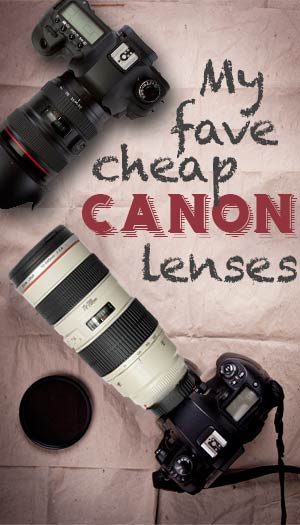





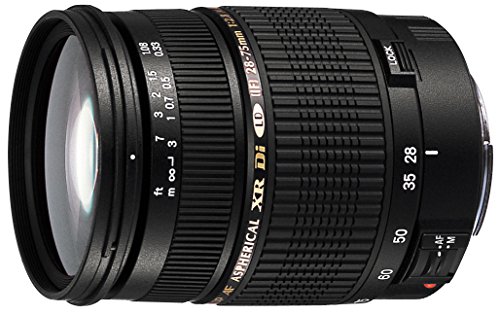
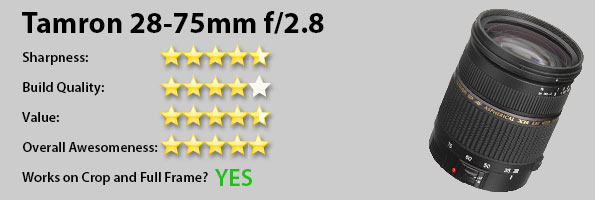
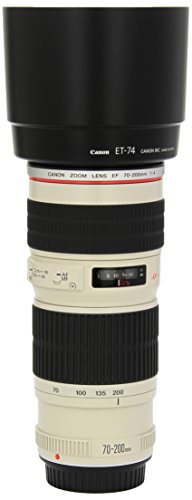
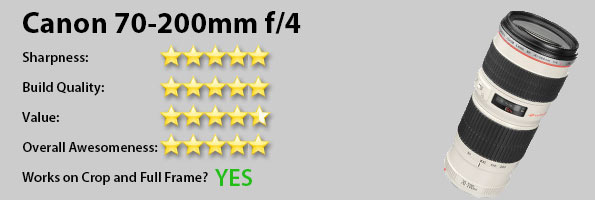

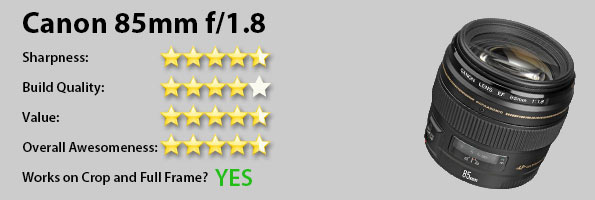

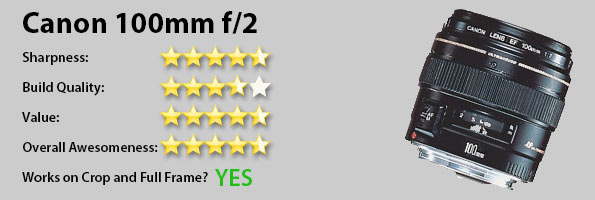

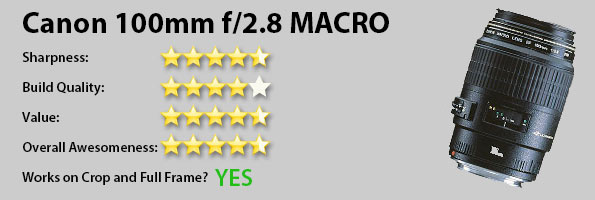


i have eos3, oes400d, 40d & 5dc. what i use per your recommended focal length ranges:
1. 28~70/f2.8 #old, but very good if on a tight budget and is able to find a good preloved copy
2. 70~300/f4~5.6 #a good compromise for a wee bit more range, but as good optically
3. 85mm f/1.5 helios 40-2 m42 #mf lens, via adapter
3. 105/f2.5 nikkor ais nikon-f #mf lens, via adapter
4. 50/f1.4 cz planar & 55/f2.8 makro-pancolar m42 #mf lenses, via adapters
on what you put in the side note
5. 17~35/f2.8 #old, but i find it better than 17~40
Hi Jim,
Thanks for this article! It contains very good information and your attention to detail is very insightful.
I would like to know more about these or other quality lenses when used on a crop sensor camera such as the 60D.
Would you make the same recommendations for this type of camera or are there others that are better suited for an APS-C camera?
The Sigma 10-20mm f/3.5-4 is a nice, affordable wide-angle zoom. The one that I have is extremely sharp, and produces excellent images. I should note that I’m not shooting Canon any more, but have moved to Sony. But the 10-20 is basically the same lens no matter the mount.
Hi Jim – Enjoyed the article and the practical perspective that you have provided. I think a serious contender for this list is the Sigma 18-35mm f1.8 DC HSM. At its price point, it can easily challenge many “L” series lenses, but it’s a lot cheaper especially considering that it can maintain such a wide aperture throughout its focal length. This lens has become my go-to lens. The other lens I regularly use is the Sigma 50mm f2.8 Macro. This was my primary lens until I got the 18-35. Obviously, I’m a big fan of Sigma. They make some really good lenses.
I know the pro photographers like f2.8. I have found for my type of shooting, that I use the 17-40/f4, 24-105/f4 IS and the 70-200/f4 IS. If I know that I will be shooting in low light, I have the 50/1.4 and the 100/f2.
The Tokina 12-24 f/4 II is a fabulously sharp lens with less vignetting at the 12 mm. setting than you would think. If I hadn’t bought a full-frame camera I’d still be using it daily. My friend who bought it does.
I was looking to purchase the Sigma 70-200 2.8f at the beginning of next year. Anyone have any comments, positive or otherwise?
I’ve used the 70-200mm f4 L series and found it a very very good lens. I’ve now got a 70-200mm 2.8 L IS and to be honest haven’t yet seen were it has the gain over the F4. (You also get the auto-focus to work if you’ve got the 2x Extender II as it won’t on the F4.)
My favorite knockabout kit setup is a 7D with a Sigma DC 17-70mm f2.8 – 4 HSM
A very good Canon L lens is the 28-70mm. It was the BOSS in it’s time as it was the 1 before they made the 24-70mm. You can get that for only £400 (about $500) which is only a fraction of the 24-70m price.
Its the lens that stays on my 5D MK II for weddings and it does a brilliant job with no complaints.
Canon 85mm f/1.8 is a great lens and from what I hear it focuses faster than the 1.2.
I’ve been using the 85 1.8 for wrestling photography now for 4 years, and it’s nice and fast. However, often it’s not wide enough. Would the Tamron 28-75 be a good choice for this application in poorly lit gyms? Or would another prime be better? I’m on a budget! Thanks for great article.
Does anyone have any comments good or bad about the camera Nikon 300 with lens Tamrom 250. I have one but not very good with it. I purchased it from my sister-in-law that works for a newspaper. Thanks for any information. Brenda
I was just given (Christmas gift) a 60mm 2.8 macro. Been reading on it and not sure if it is right
for what I’m shooting. I do indoor & outdoor portrait photography. My 50mm indoors is a little
tight sometimes. Should I think of returning & getting a 85mm. I prefer outdoors and am lucky
that weather permits year round. Thanks for any input.
Thanks You very much. This guide is amazing. Helped a lot….
D lens is a very good lens 70 to 200.2.8
I really love my Canon cameras. The nifty 50 is a wonderful lens for the money. The high end Canon lenses are so far out of my reach. I love my Tamron 17 – 50 2.8. I think Sigma is also a great value. You folks with crop sensor cameras would do well to buy full frame compatible lenses.
I’ve been needing an upgrade from the cheapo 75-300mm for years. What I WANT is the 100-400mm, but it’s just too far out of my budget. I shoot a lot of birds flying all over the place, so I need a zoom with a decent range (though I could deal if it’s not quite that big). I do need at least 300 mm, preferably closer to 400. My research doesn’t seem to be turning up much at a reasonable price that really fits what I need. Do you have any suggestions? Is the EF 70-300mm f/4-5.6 IS USM really that much better than the EF 75-300mm f/4-5.6 III USM?
I’ve bought 28-75 f/2.8 Tamron lens… and it’s a decent lens at a lower price you won’t regret and may even at par with my L lens
40mm 2.8 STM is my favourite bang for buck lens
Thank you for the astute comments. I have most of the lenses on your list and your opinions coincide with my experience. I have the superb Canon 200mm f2.8L II that I bought used on e-bay for $550 in mint condition. This is inexpensive for what is now my sharpest lens. I evaluated 4 copies of the Tamron 17-50 f2.8; non VR. Three were decent, one was very sharp–so I bought the sharpest one and it serves well on my Canon 7D. I just bought the Canon 40mm f2.8 and it is amazingly sharp at f2.8, albeit at a higher cost than the Canon 50mm f1.8 II. As much as I hate to admit it, the 40/2.8 is a tad sharper than my excellent Canon 50mm f1.8 metal mount at f2.8. DrJ